Lobelia cardinalis, cardinal flower, is a native perennial herbaceous plant with stunning deep red flowers that bloom in the summer.
Flowers
Inflorescence - flower cluster:
Lobelia cardinalis, cardinal flower, produces flowers that appear along the upper section of a upright usually unbranched stem. This spike-like cluster of flowers is termed a raceme because it's flowers are on short pedicels (flower stalks). The raceme of flowers can be up to 2 feet long - from one-fourth to one-third of the height of the plant.
The flowers start to mature starting from the bottom. Shown in the left photo, the flowers on the bottom are finished and those on the very top are still buds.
The process of maturing can take up to a month so that the time for pollination is staggered.
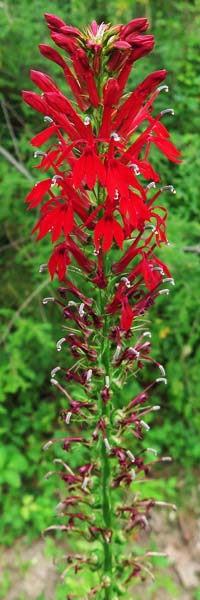
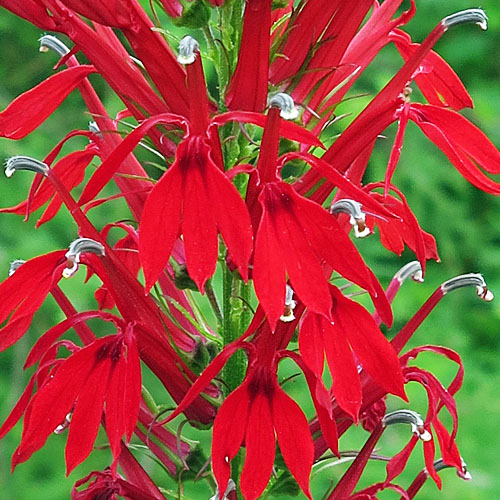
Individual flowers:
The cardinal flower plant has a tube shaped flower which consists of 5 petals, opened/separated at the top, that unite and form a tube (corolla tube) at the base. Sometimes the flowers are describe as two-lipped with the upper lip divided into two lobes and the bottow lip divided into 3 lobes. The corolla tube is about 0.75 inches long with nectar glands at the bottom. The length of the tube creates a problem for pollinators.
Protruding from the corolla tube is the reproductive structure that rises above the petals. It is different from most flowers and consists of 5 fused stamens (male parts - filaments & anthers) that forms a tube around the style and stigma (female parts).
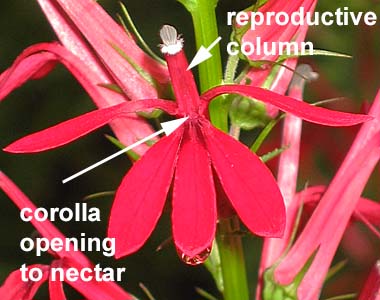
The flowers are protandrous (male parts mature before female parts). The flowers go through two phases, starting with the male phase and then after a few days it goes to the female phase. So, the male flowers will be higher up on the stem and the female flowers lower down and can be seen in some of the photos above and below.
In the male phase the female parts are not visible and there some white bristles refered to as the "beard" at the end of the fused anthers (gray part). In the female phase, the style has elongated inside the tube and the stigma pushes through the end of the fused anther tube. When matured, the stigma opens up to be receptive to pollen.
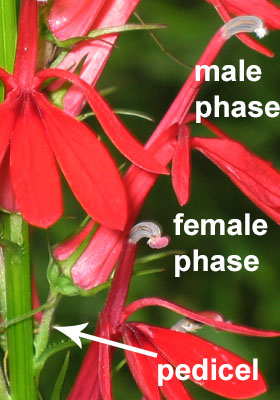
This photo shows the long tubular flower in the male phase. The lower flower is in the female phase. Also shown is the pedicel which distinguishes a raceme from a spike flower arrangement.
Closeups of the male phase of the flower : At the end of the fused anthers (gray area) are the brushes which are often refered to as a "beard". In the left photo there is some pollen, but not a lot under the beard.
Surprisingly, this area was not covered with pollen on any of the male flowers we observed. Apparently the pollen is conservatively released and frequently picked up by pollinators.
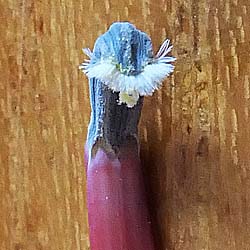
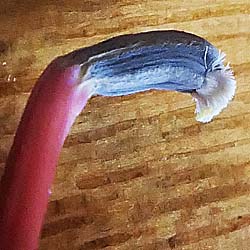
Closeups of the female phase of the flower: The style and stigma has pushed through the end of the fused anther tube and the stigma is open and ready to receive pollen.
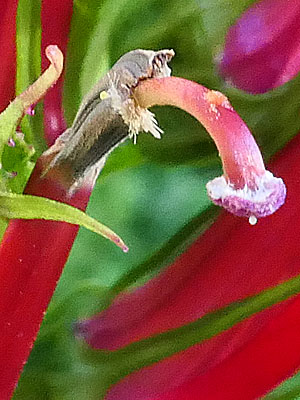
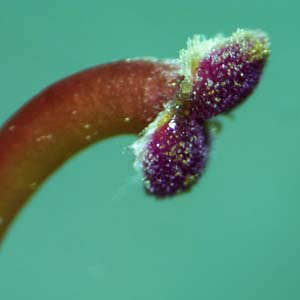
Where is the pollen? You don't see pollen on the surface of the anthers. The pollen is hidden! When the anthers mature the pollen is released into the inside of the tube (inward dehisence)! How does that help the plant? Since we have the plant growing in our yard we sacrificed a few flowers and looked at the reproductive structures and took photos through the microscope that are shown here.
As the style slowly grows the stigma which has a collar of bristles move forward and act as a plunger and pushes the the pollen slowly up and out through an orifice to the outside near the "beard" where the pollen is then picked by pollinators. This moving the pollen to a location more accessable to a pollinator is called - secondary pollen presentation.
The style continues to grow and will reach the end of the fused anther tube and break through and the flower will be in the female phase. Note in the photos above, after a while in the female phase, the stigma loses the collar of bristles.
Below are photos through the microscope looking inside the fused stamen tube which was carefully slit open.:
We opened the fused anthers and the interior was filled with sticky yellow pollen.
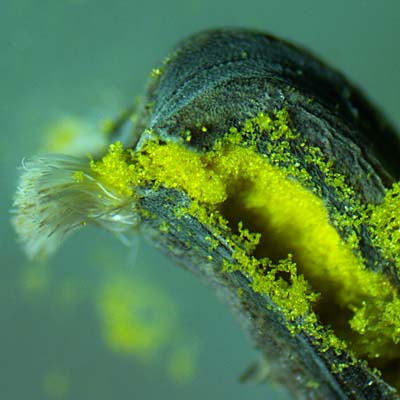
Clearing away some of the pollen revealed the stigma with its collar of bristles and the style inside the fused anther.
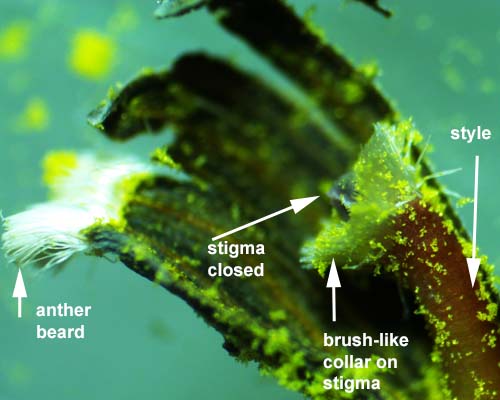
The stigma is closed and has a collar of bristles around it to sweep the pollen forward as the style grows longer.
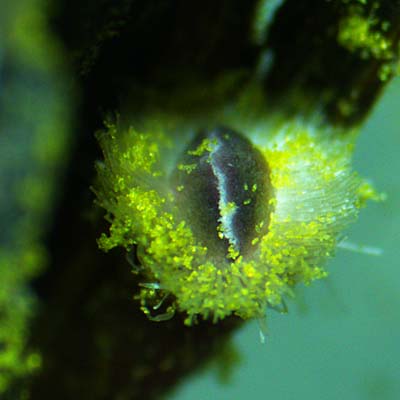
Separating the style and stigma from the broken fused anthers gives a clearer picture of the style and collar of bristles around the stigma and the tip of the stigma.
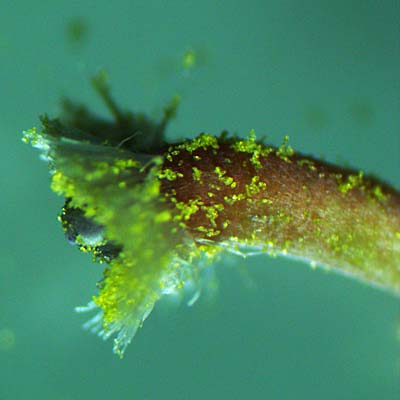
The stigma peeks out just before it breaks through the anther tube.
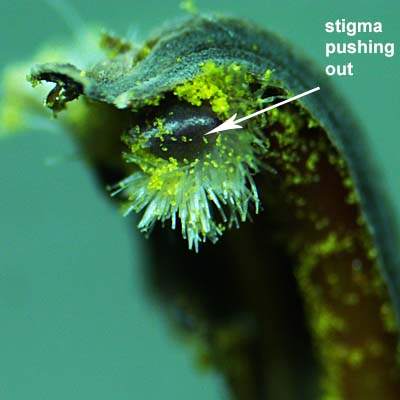
This is a process that is common to all the lobelias. The flower of the cardinal flower is one of the largest NJ lobelia flowers which makes it a good candidate to investigate.
Pollination It is about 0.75 inches down the flower throat to get to the nectar. This creates a problem for many birds and insects.
The hummingbird appears to be well suited to get the nectar and to pollinate the cardinal flower. There are many photographs on the internet showing how the anther beard or the stigma touches the head of a hummingbird when it is sipping nectar.
The spicebush swallowtail butterfly has a long enough proboscis to get the nectar but it does not pollinate the flower well.
The hummingbird comes several times a day to allow time for the nectar to be replenished in the flowers, however, if the spicebush swallowtail comes in between, there will not be any nectar for the hummingbird.
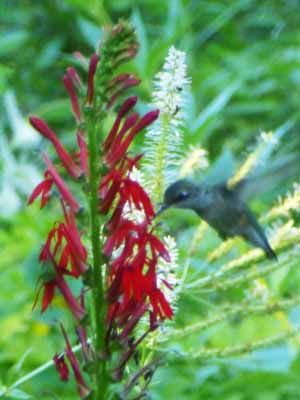
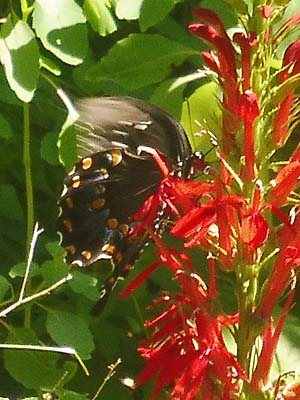
Fruit
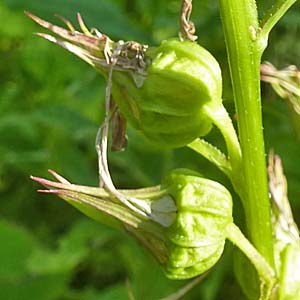
While the flowers at top of the plant may still be in bloom, lower down the flower stalk may be developing fruits.
Leaves, Plant and Habitat.
In nature, cardinal flower grows in marshes, shores of rivers or lakes, wetland margins (edges of wetlands). It likes it's feet wet. However, it is not very common.

The plant stem is stiff upright and 2 - 4 feet tall. As can be seen from the photo the flowering section can be quite large. The leaves, further down can be easily 6 inches long.
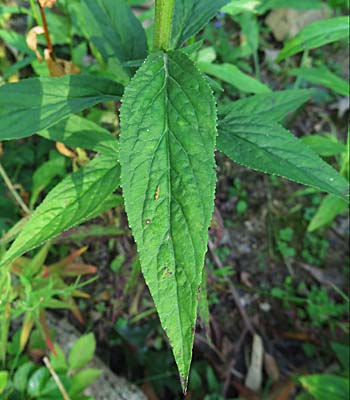 When the plant is very vigorous, it will send flower stalks from the leaf axils.
When the plant is very vigorous, it will send flower stalks from the leaf axils.
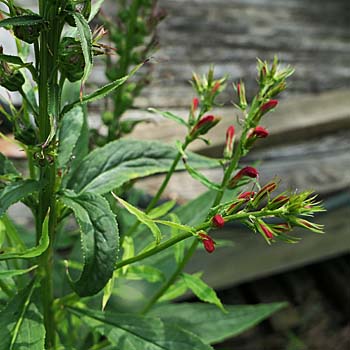
At the end of the growing season, the plant stalk dies back.However, during the growing season, it sends out many rhizomes which root and sends out rosettes of leaves. The rosettes of leaves over winter.
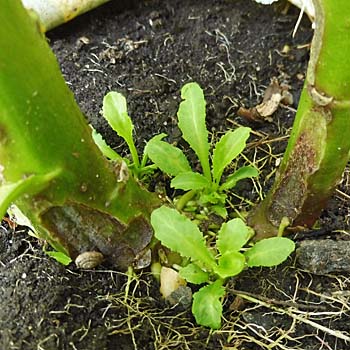 The photo shows basal rosettes forming in the summer, here in August.
The photo shows basal rosettes forming in the summer, here in August.
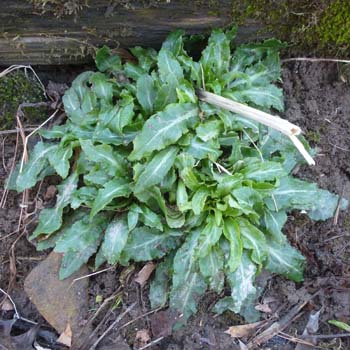 The photo shows basal rosettes the following spring. The previous year's plant stalk is still visible
The photo shows basal rosettes the following spring. The previous year's plant stalk is still visible
Text by Millie Ling. Photos by Hubert & Millie Ling: flowers - July, other photos later, in cultivation, NJ.
Cultivation
The cultivation material below is courtesy of
Jersey Friendly Yards searchable plant database: Lobelia cardinalis
In NJ it blooms from July through September. It requires moist-wet soil for best growth. It prefers partly shady areas but it can tolerate full shade.
Hardiness Zone: 6a, 6b, 7a, 7b
Physiographic Region: All Regions in NJ
Salt Tolerance: Low to None
Soil Type: Loam, Organic
Soil Moisture: Medium-drained, Wet
Drought Tolerance: Medium
Soil pH: Acidic, Slightly Acidic, Neutral, Slightly Alkaline
Optimal Light: Partial Shade
Light Range: Full Sun, Partial Shade, Shade
Growth Rate: Medium
Additional information
Additional information / references:
Information on Cardinal flower - secondary pollen presentation with references and links to photos: http://iowaplants.com/flora/family/Campanulaceae/lobelia/Lobelia_spp.html
The USDA website shows its distribution almost everywhere in NJ.
https://plants.usda.gov/core/profile?symbol=LOCA2
Good gardening information: Jersey Friendly Yards
https://www.jerseyyards.org/plant/lobelia-cardinalis/